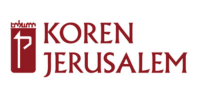We’ll be doing our annual inventory January 12–16; orders placed after January 7 will ship starting January 19

 How does this relate to Koren font? As noted in a previous post,Eliyahu Koren was a master graphic designer and typographer in his own right. In order to develop a unique font for the Tanakh, Koren consulted with other typographers, Hebrew grammarians, and even optometrists. The goal was to develop the most easy-to-read and accurate Hebrew font available. After his edition of Tanakh was published in 1962, Eliyahu Koren went on to develop a unique font for the siddur as well. As with the Bible, Jewish prayer, should have its own distinct font.
How does this relate to Koren font? As noted in a previous post,Eliyahu Koren was a master graphic designer and typographer in his own right. In order to develop a unique font for the Tanakh, Koren consulted with other typographers, Hebrew grammarians, and even optometrists. The goal was to develop the most easy-to-read and accurate Hebrew font available. After his edition of Tanakh was published in 1962, Eliyahu Koren went on to develop a unique font for the siddur as well. As with the Bible, Jewish prayer, should have its own distinct font.
 The newly digitized Rashi font as seen in Koren's editions of Tanakh and even the Noé Edition Koren Talmud Bavli hasslightly different versions of each and every letter depending on the position of the letter and which nikkud
The newly digitized Rashi font as seen in Koren's editions of Tanakh and even the Noé Edition Koren Talmud Bavli hasslightly different versions of each and every letter depending on the position of the letter and which nikkud  Now have a look at the “hey” at the beginning and the end of the word. The front ‘leg’ of the hey is shorter than the last letter. This makes room for the ‘nun’ that comes before it, and at the same time resembles the authentic look of the Rashi script in original medieval manuscripts:
Now have a look at the “hey” at the beginning and the end of the word. The front ‘leg’ of the hey is shorter than the last letter. This makes room for the ‘nun’ that comes before it, and at the same time resembles the authentic look of the Rashi script in original medieval manuscripts:
 The first dated Hebrew book was Rashi's commentary on the Torah, printed in 1475 in Reggio di Calabria. There are some letters that are longer, resembling real handwriting. Koren's Rashi script strives to restore this look.
The first dated Hebrew book was Rashi's commentary on the Torah, printed in 1475 in Reggio di Calabria. There are some letters that are longer, resembling real handwriting. Koren's Rashi script strives to restore this look. The reasoning behind these different versions was to allow for adjacent letters to fit together in an aesthetic sense, and, so it would look more like natural handwriting. Our graphic designers incorporated this guiding principles into the digitized font, which can be seen here in the word “Nitpayasta” (‘you reconciled
The reasoning behind these different versions was to allow for adjacent letters to fit together in an aesthetic sense, and, so it would look more like natural handwriting. Our graphic designers incorporated this guiding principles into the digitized font, which can be seen here in the word “Nitpayasta” (‘you reconciled  The tav at the end swings around, resembling how one might write a letter at the end of a script word. The result is a Rashi font that is easier on the eyes, facilitates one's ability to read the text, and restores a more accurate presentation of how Rashi script looked when it was first published in the 15th century.
There are many more examples of the nuances in the Koren Rashi font, but you'll have to search for yourself! For one day only (Thursday August 1st ...mark you calendars!) , get 40% off all editions of the Koren Humash Rashi and the Humash HaMevoar,an all-Hebrew edition on the Humash with Rabbi Steinsaltz's commentary.
The tav at the end swings around, resembling how one might write a letter at the end of a script word. The result is a Rashi font that is easier on the eyes, facilitates one's ability to read the text, and restores a more accurate presentation of how Rashi script looked when it was first published in the 15th century.
There are many more examples of the nuances in the Koren Rashi font, but you'll have to search for yourself! For one day only (Thursday August 1st ...mark you calendars!) , get 40% off all editions of the Koren Humash Rashi and the Humash HaMevoar,an all-Hebrew edition on the Humash with Rabbi Steinsaltz's commentary.
 HaTanakh HaMevoar - 5 volume Humash
HaTanakh HaMevoar - 5 volume Humash Koren Humash Rashi
Koren Humash RashiDays
Hours
Minutes
Seconds

